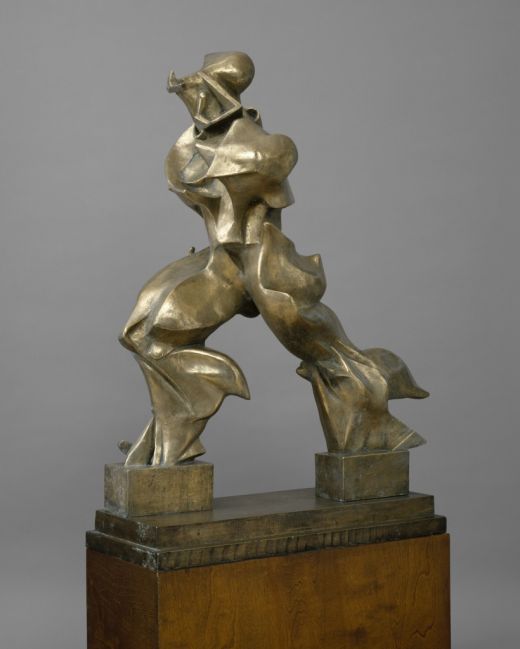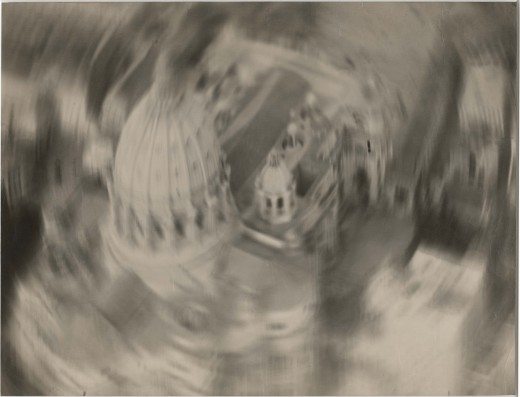Italian Futurism, 1909-1944: Reconstructing the Universe
Liz Shannon

Umberto Boccioni, Unique Forms of Continuity in Space (Forme uniche della continuità nello spazio), 1913 (cast 1949). Bronze, 121.3 x 88.9 x 40 cm. The Metropolitan Museum of Art, New York, Bequest of Lydia Winston Malbin, 1989. Image Source: Art Resource, New York © The Metropolitan Museum of Art.
February 21 – September 1, 2014
In 1909 the Italian poet (and consummate self-publicist) Filippo Tommaso Marinetti introduced Italian Futurism to an international audience, through the publication of his first Futurist manifesto on the front page of leading Parisian newspaper La Figaro. Launched into the heart of the art world, Marinetti’s manifesto promoted Futurism as a new art borne of violent struggle, explicitly rejecting Italy’s status as the center for art of the past, with phrases such as “Set fire to the library shelves! Turn aside the canals to flood the museums!”
Thrilling and poisonous by turns, Marinetti’s carefully calibrated text attempts to invigorate and inspire the reader with its celebration of youth, dynamism, and technology. It also succeeds in being one of the most ridiculously offensive manifestos in the history of art, slinging insults at an impressive range of society, including women, librarians, cyclists, and anyone over the age of forty. Although still able to cause a rush of blood to the head, the thoughtful presentation of the Guggenheim’s latest exhibition, Italian Futurism, 1909-1944: Reconstructing the Universe, tones down the riotous passion of the manifesto that launched the movement and enables us to consider Futurism in full.
The Guggenheim’s show is the first comprehensive exhibition of works by the Italian Futurists to be presented in the United States. A whopping seven years in the making, it features over 360 works by more than 80 artists working in an astonishing variety of disciplines, covering over 30 years of Futurist art practice. This presentation is particularly special due to the high number of works rarely—if ever—seen in the U.S., which have been borrowed from foreign institutions. Pleasingly for South Floridians, the exhibition also contains a number of works drawn from the collection of the Wolfsonian.

Filippo Masoero, Descending over San Pietro (Scendendo su San Pietro), ca. 1927–37 (possibly 1930–33). Gelatin silver print, 24 x 31.5 cm. Touring Club Italiano Archive
These contradictions are summarized by artwork displayed along the first curve of the ramp and in the final room. The exhibition opens with Umberto Boccioni’s iconic sculptural works based around his concept of “plastic dynamism,” including “Development of a Bottle in Space” (1912), and continues with Marinetti’s first manifesto, in which the poet pointedly insisted upon “scorn for women” and war as “the world’s only hygiene.” In the final room hang five huge paintings celebrating modern communications. Executed for Palermo’s Fascist-era post office in the early 1930s—long after the deaths of Boccioni and a number of other Futurist talents in World War I—the works were created by Benedetta, a rare female Futurist, who was also Marinetti’s wife. Taken together, these displays illustrate the compromising of many of Futurism’s original aims and signal some of the movement’s twists and turns, expansions and contractions.
As befits a movement heavily predicated upon the written word, Futurism produced a large number of manifestos over its thirty-year lifespan, as new waves of Futurists struggled to delineate precisely what a Futurist artwork could and should be. Subjects for manifestos included the usual suspects of painting, sculpture, photography, architecture, music, and literature, but since the movement ultimately aimed to encompass all aspects of life through the creation of the total work of art (l’opere d’arte totale, based on the German model of Gesamtkunstwerk), more unusual topics such as lust and cooking were also addressed. This veritable avalanche of Futurist manifestos could imply that the movement was highly resolved, but the variety of approaches and types of work produced demonstrates that this was not the case.
Futurist artists may have strained to find a suitable means of depicting their modern, dynamic subject matter, but they seemed not to be particularly concerned by their tendency to work in highly traditional media. Indeed, while it is invigorating to see so many of Futurism’s landmark artworks in one place, the exhibition challenges the movement’s predilection for the unsentimental destruction of the old in favor of the new due to the sheer volume of large painted canvases and sculptures constructed from materials such as bronze which conventionally connote Fine Art.
Some artists did make attempts to produce Futurist art using new(er) technologies such as photography and film. Brothers Anton Giulio and Arturo Bragaglia made earnest attempts to delineate a Futurist photography during the movement’s early years, and the exhibition includes an excerpt from the only extant Futurist film, Thaïs (1916), directed by the elder brother. While heroic-era Futurist’s choice of media tended to be traditional, the works that they created were not. Furthermore, the broad selection of Futurist paintings on display reveals the influences of, and relationships to, other contemporary avant-garde styles and movements, particularly Pointillism, Divisionism, and Cubism. However, by the early 1930s Futurism’s avant-garde edge had become dulled. The highly abstracted paintings of Giacomo Balla and other early Futurists display a vibrancy almost entirely absent from much of the work produced during the movement’s attempts to capture the imagination of Il Duce. Comparison of Boccioni’s “Unique Forms of Continuity in Space” (1913) and later sculptural work such as Thayaht’s “Victory of the Air” (ca. 1931) creates an unfavorable contrast between the originality and dynamism of the former, and the stylized, predominantly decorative qualities of the latter, which tend to look rather feeble by comparison.
Some of the exhibition’s most interesting works are located outside of the traditional fine arts, and it is in these sections that the show succeeds in outlining the full scope of Futurism’s ambition. Theater performances, costumes (including a now-wilted garment featuring a giant fabric propeller), and stage sets are presented alongside examples of Futurist ceramics, furniture (more often than not made utilizing traditional methods and materials rather than new technologies), and advertisements. Futurism’s literary aspect is also voluminously present through books, pamphlets, and other intriguing ephemera. A particular highlight is found in works described as “words in freedom,” somewhat similar to concrete poetry, which were designed to be experienced as art, as poetry, and in performance. Utilizing line, color, and sound (through onomatopoeia and vocal presentation), these pieces have a lightness of touch absent from much of the movement’s painting and sculpture, and perhaps most clearly express Futurism’s untempered dynamism and revolutionary spirit.
The curators have endeavored to create a sense of Futurism’s numerous anarchic performative aspects through the presence of audio, film, and photographic slideshows of Futurist events, but overall these restrained presentations fall a little flat. Inevitably, perhaps, something of Futurism’s excitement and hyperbole is lost through this careful museum presentation. Certain items certainly lose their edge through presentation in a museum context: for example, Futurist waistcoats designed by Fortunato Depero, a leading figure of Futurism’s second wave, are displayed straight, as quirky artifacts featuring unusual, colorful designs. However, photographs from the 1930s show Depero and Marinetti wearing their waistcoats with suits, bow ties, and bowler hats—the uniform of the bourgeoisie. Standing on the street alongside other conventionally dressed men, they strike a strident, aggressive note in their strange attire. The context gives the garments a new significance.
Nevertheless, the Guggenheim’s curators have done an incomparable job of mastering a difficult, cacophonous, and multi-disciplinary movement, and marshaling a huge number of works. Rather than presenting a mass of objects blasting and shouting over one another for the visitor’s attention (which might be closer to a Futurist reality), they have created a landmark exhibition that clearly communicate the complexities and abiding interest of Italian Futurism.










